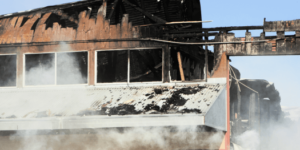Experiencing a fire in your home can be a devastating event. In this article, we will provide you with practical tips on how to restore your property after fire damage.
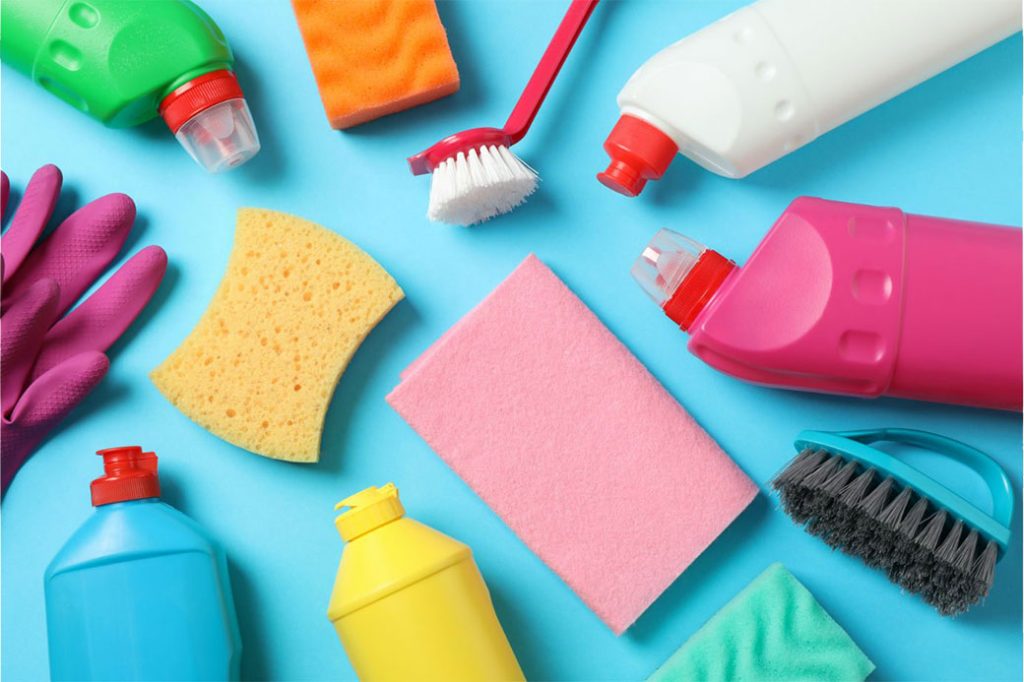
Essential Supplies
PPE
Use protective gear to protect yourself from the harmful effects of smoke and soot. Wear durable clothing that covers your entire body and you don’t mind getting very dirty. Use protective glasses or goggles to keep loose soot out of your eyes. Rubber gloves are sufficient for most things, but wear work gloves if you’re cleaning up any debris. You’ll need to use an N95 or FFP3 mask to filter out the small particles of soot.
These special sponges are essential for cleaning up soot after a fire. They’re made of vulcanized rubber that’s perfect for capturing soot. You can pick them up at most home improvement depots or restoration supply stores.
Use them on any dry surface without any liquid. They can be washed and reused, but they’re particularly difficult to wash and they must dry completely before reuse. Most surfaces are ideal, but a soot-cleaning chemical works better for polished metals.
Dry Sponge Extension Pole (With Clamp)
You can reach high ceilings and low floors with these extension poles that can fasten a sponge on the end of them. Some home improvement depots have these, but you’ll have better luck at a restoration supply store.
Fire Damage Cleaning Chemicals
Regular household cleaners will destroy your home when they come into contact with soot. Once you mix most of these cleaners with soot they smear and become incredibly difficult to clean.
Visit a restoration supply store to get a general soot-cleaning chemical and a heavy-duty degreaser to clean up any soot-grease messes.
If there’s only a small amount of soot, regular vacuum bags should be fine. If you’re vacuuming soot in multiple rooms, you’re going to need vacuum bags that can filter out small particles. You can get these at most home improvement depots or restoration supply stores.
Rags, Brushes, and General Cleaners
After all of the debris and soot is cleaned up you can use your typical cleaning supplies to make sure everything is thoroughly cleaned.
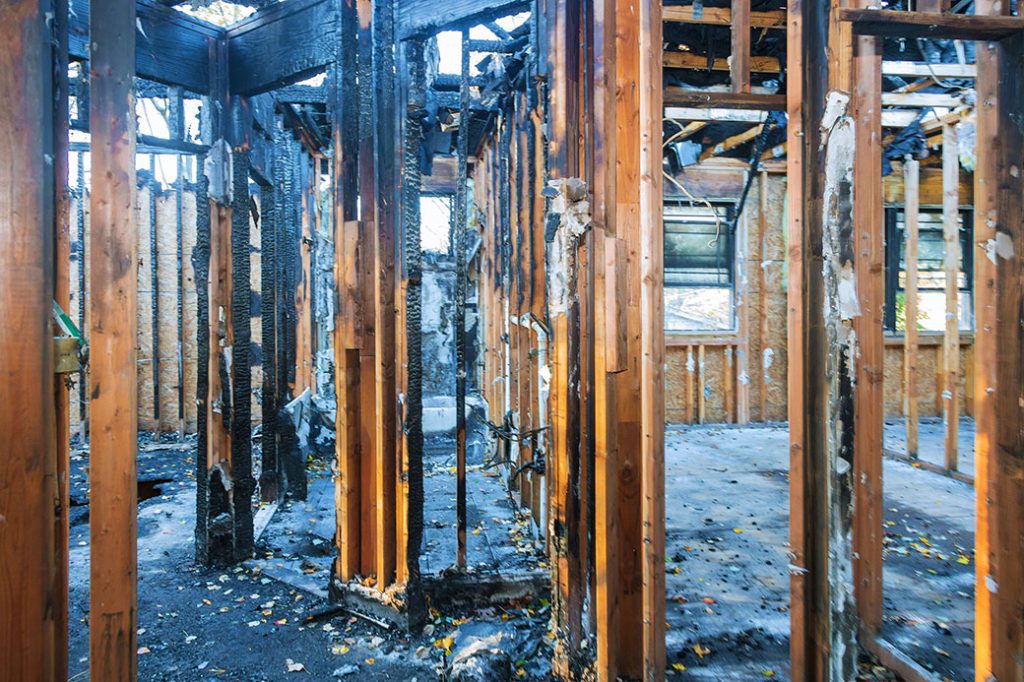
Structural Cleaning
Walls
Begin by removing loose debris and soot from the walls using the soot-cleaning dry sponges. Gently wipe the surface to remove smoke residue, being cautious to apply firm, but not excessive pressure.
Windows
Wipe the glass with a dry sponge. Then, after ALL of the loose soot is cleaned up, use a vacuum cleaner with a brush attachment to remove loose soot from the window sills.
After ALL of the loose soot is cleaned up, you can use window cleaner to remove any remaining smoke residue.
Studs
If there are any exposed studs affected by the fire, first consult with a professional to address the structural integrity of your home.
As long as the structure is solid, you can begin restoring the studs. If there’s just some light smoke damage, simply wipe the studs down with the dry sponges.
If they’re charred, they’ll need to be sandblasted. You can rent a sandblaster, but it’s fairly difficult so we recommend hiring a professional.
Last, encapsulate the studs in an odor-blocking primer to seal away any residual smoke odor.
Ceilings
Use the dry sponges with the extension poles to remove soot from the ceilings and upper walls.
Cleaning Lights and Fans
Remove any detachable parts from ceiling lights and fans and clean them individually with the soot-cleaning chemical. You may need to circle back to clean any hard-to-reach places with a brush and vacuum after ALL the loose soot is cleaned up.
HVAC Vents
First off, make sure the HVAC system is turned off for the entire cleaning process.
Remove the vent covers, wipe them down with dry sponges, then use soot-cleaning chemical if necessary.
For thorough cleaning of the ducts, it’s advisable to seek assistance from a professional fire damage restoration company.
Flooring
Carpets: Tear out and throw the carpet away after the ceiling and walls are cleaned to minimize the cleaning the floor will need. We highly recommend replacing your carpet instead of trying to clean it, but you can try vacuuming it several times and cleaning it with a carpet cleaner with some of the soot-cleaning chemical if you must.
Hardwoods: Assess the damage to hardwood floors. Severe damage may require refinishing or replacement. If the damage is minimal, clean it with dry sponges. You can also clean it with a regular floor cleaner after ALL the loose soot is cleaned up.
Tile: The tricky part with tile is the grout. You’ll need to gently wipe all of the tile with dry sponges, then gently use a vacuum with a brush attachment to get up as much of the soot as possible. Next, use the soot-cleaning chemical for the best chance of removing all of the soot.
Vinyl or Linoleum Floors: These will need to be replaced if they’re damaged by fire at all. You can clean them easily with dry sponges if not.
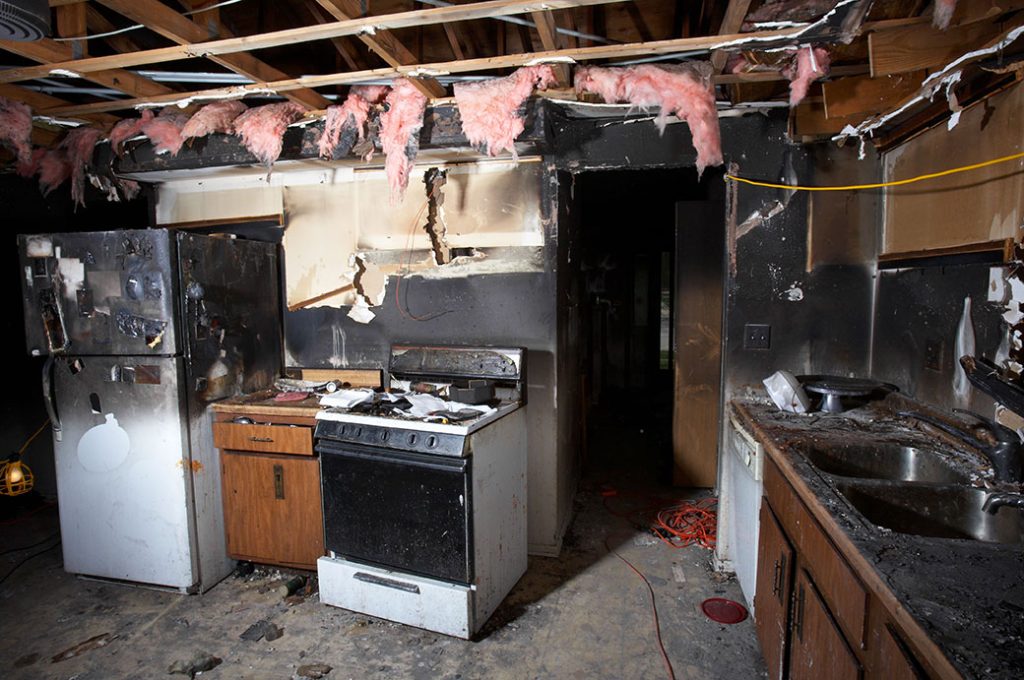
Appliances and Electronics
Before cleaning, ensure that all appliances and electronics affected by smoke are disconnected from power sources.
If they’re burned from fire in any way, take them to a professional that specializes in cleaning appliances and electronics to see if they can be restored. Unfortunately, your appliances and electronics may still be ruined just by soot because it causes corrosion and disintegration to metal.
Use the soot-cleaning chemical for anything metal and a dry sponge for anything else if the soot and smoke damage is minimal. If you’re using a spray bottle, make sure to never spray the electronics or appliances directly.
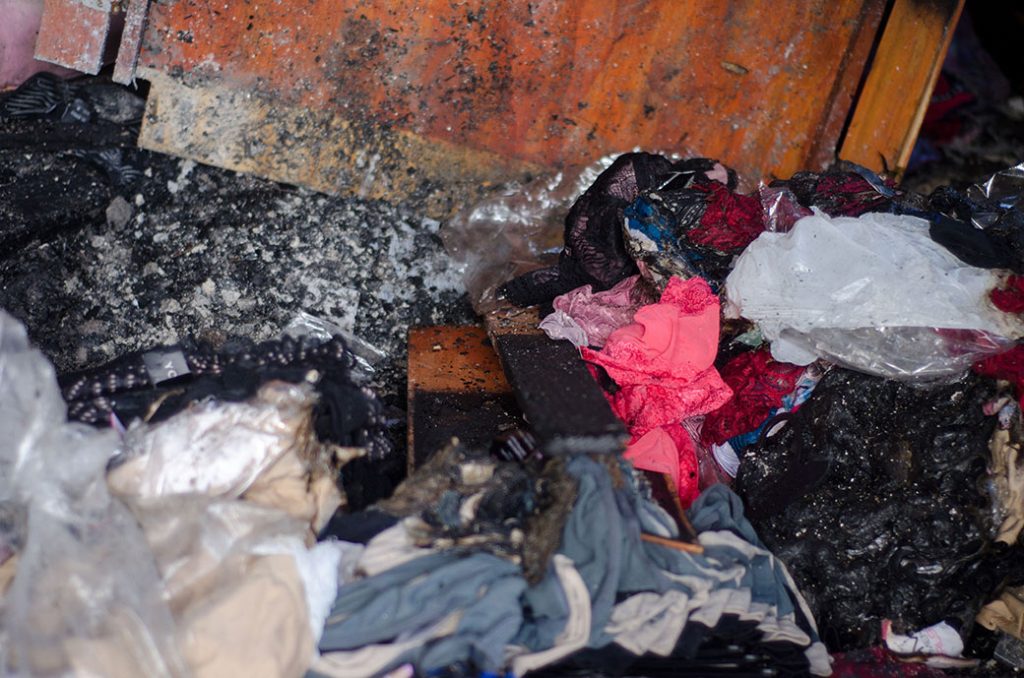
Furniture, Clothing, Plastics, Books, and Food
Furniture
Upholstery: This can be extremely difficult to clean effectively due to the depth of some upholstery. However, you can use a vacuum with a brush attachment to give it a shot.
Hard Surfaces: Use a dry sponge to remove all of the soot. You may also need a small cleaning brush to reach some areas.
Clothing
Sorting: Separate heavily affected clothing from lightly affected clothing to prevent further contamination.
Shake and Brush: Shake the clothing items outdoors to remove loose soot particles. Use a soft-bristle brush to gently brush off any remaining soot.
Laundering: Follow the garment’s care instructions and wash the clothing items using an appropriate detergent. Consider adding an odor-neutralizing product to the wash to remove smoke odors effectively.
Dry Cleaning: Delicate or dry-clean-only garments should be taken to a professional dry cleaner experienced in handling fire-damaged clothing.
Plastics
Inspect: Examine plastic items for signs of melting, warping, or discoloration. Discard any plastics that have been significantly damaged.
Clean: For lightly soiled plastic items, wash them using the soot-cleaning chemical and warm water. Gently scrub with a soft cloth or sponge, then rinse thoroughly.
Disinfect: If necessary, use a solution of one part bleach to nine parts water to disinfect plastic items.
Books
Air Circulation: Allow the books to have light air circulation in a dry area to minimize further damage.
Gentle Cleaning: Gently brush off loose soot from the book covers and pages using dry sponges. Use gentle, light strokes to avoid smudging.
Food
Discard: Throw out any food items that may have been exposed to smoke, heat, or fire. High temperatures during a fire can compromise the safety and quality of stored food. Dispose of any perishable items, including open packages, as they may have been contaminated.
Examine: Inspect non-perishable food items stored in sealed containers for signs of damage or exposure. If the packaging appears compromised or if you suspect contamination, it’s best to err on the side of caution and discard them.
Remember, professional assistance may be necessary for complex restoration tasks and valuable items. Focus on safety, seek expert advice when needed, and approach the restoration process with patience.






